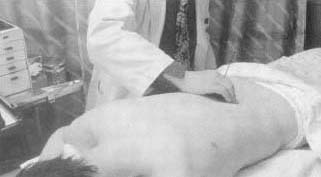Acupuncture
Acupuncture is an ancient method for relieving pain and treating disease using very fine metal needles. While the invention date of acupuncture is not known, the theory behind it has been handed down through the centuries. According to acupuncture practitioners, certain points on the surface of the body are linked to internal organs. When a patient becomes ill, the illness often manifests itself on a surface site. Treating the external site—or a specific area of skin—creates a link to the internal imbalance.
Philosophy Explains Illness
Early Chinese medical practitioners learned that certain areas of the skin showed sensitivity during illness or organ malfunction. These points of sensitivity were discovered to be part of a pattern. Chinese doctors drew "body maps" to help keep track of the various points. The lines they used to connect the pattern points were called meridians. Each meridian was linked to certain body organs and physical conditions.
According to Chinese Taoist philosophy (a system of religion based on the teachings of philosopher Lao-tse), these points of skin sensitivity relate to the life force or energy called Qi, which circulates throughout the

The basic reference book on acupuncture is the Nei Ching, or Yellow Emperor's Classic of Internal Medicine, said to have been written by Huang Ti (2697-2596 B.C. ), also known as the Yellow Emperor. The Nei Ching, or "Canon of Internal Medicine," is divided into two parts. The first, Su Wen, explains the theoretical basis of Chinese medicine. The second, Ling Shu, tells exactly how to use acupuncture to treat and prevent every then-known disease and gives detailed needle insertion points. An edition of the original Nei Ching was compiled by Wang Ping in A.D. 762 and revised around A.D. 1200. This later edition is the basis for the modern Nei Ching, which remains the foundation of today's acupuncture.
Early Acupuncture Tools
The earliest acupuncture needles are thought to have been made of stone, fish bones, and bamboo. These materials were later replaced by metals such as copper, brass, silver, and gold. Today most acupuncture needles are made of stainless steel, gold, or silver. The needles may be several inches long and are inserted to various depths and then twirled or vibrated. A tiny electric charge may be added. Insertion is painless or, at the most, mildly uncomfortable for a moment. Acupuncture students practice needle insertion on themselves thousands of times while perfecting their technique. The Nei Ching prescribed 365 insertion points; modern acupuncturists use 650 to 800.
Westerners Experiment with Acupuncture
Knowledge of acupuncture was brought to the West by Jesuit missionaries in the 1600s, although detailed descriptions of acupuncture theory and practice were not available to Westerners until Soulie de Morant's writings in the 1940s. Western interest in acupuncture, as well as the medical philosophies that accompany its practice, has been growing steadily since then.
Today, acupuncture is still an important element of Chinese medicine. In fact, acupuncture is often used as an anesthetic when major surgery is performed in China. Western scientists acknowledge acupuncture's effectiveness, noting that the skin does in fact have different levels of electrical resistance at the ancient acupuncture points. Western researchers speculate that acupuncture may stimulate production of the body's natural pain relievers, or endorphins, or it may interrupt nervous system pain messages.
[See also Anesthesia ; Endorphin and enkephalin ; Surgical instruments ]
Comment about this article, ask questions, or add new information about this topic: